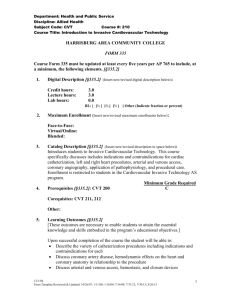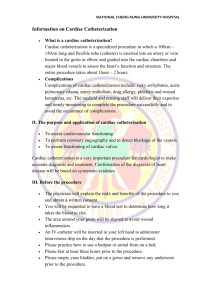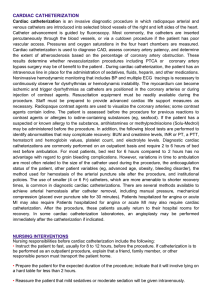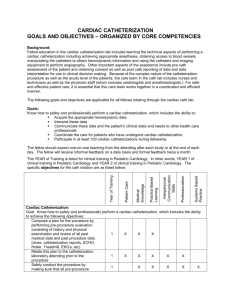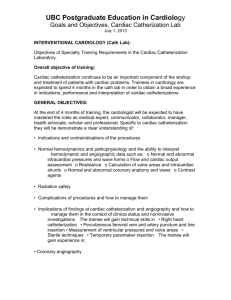Cognitive and Procedural Skills for Cardiothoracic Surgery Residents in Diagnostic... Therapeutic Cardiovascular Disease: Echocardiography, and Diagnostic and
advertisement
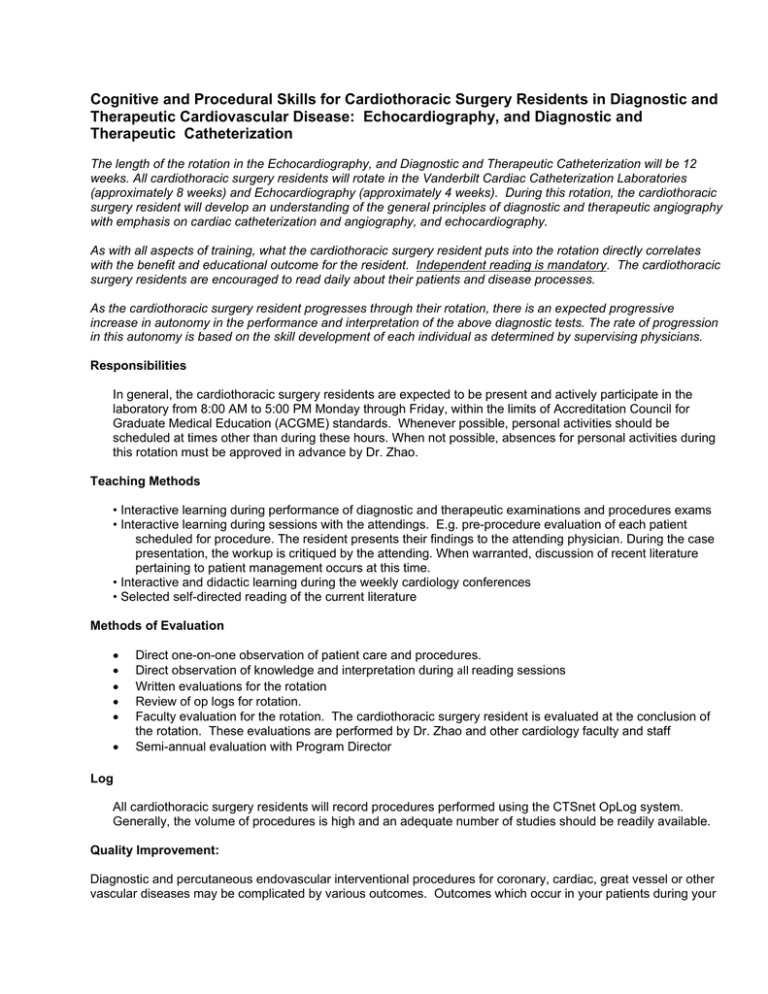
Cognitive and Procedural Skills for Cardiothoracic Surgery Residents in Diagnostic and Therapeutic Cardiovascular Disease: Echocardiography, and Diagnostic and Therapeutic Catheterization The length of the rotation in the Echocardiography, and Diagnostic and Therapeutic Catheterization will be 12 weeks. All cardiothoracic surgery residents will rotate in the Vanderbilt Cardiac Catheterization Laboratories (approximately 8 weeks) and Echocardiography (approximately 4 weeks). During this rotation, the cardiothoracic surgery resident will develop an understanding of the general principles of diagnostic and therapeutic angiography with emphasis on cardiac catheterization and angiography, and echocardiography. As with all aspects of training, what the cardiothoracic surgery resident puts into the rotation directly correlates with the benefit and educational outcome for the resident. Independent reading is mandatory. The cardiothoracic surgery residents are encouraged to read daily about their patients and disease processes. As the cardiothoracic surgery resident progresses through their rotation, there is an expected progressive increase in autonomy in the performance and interpretation of the above diagnostic tests. The rate of progression in this autonomy is based on the skill development of each individual as determined by supervising physicians. Responsibilities In general, the cardiothoracic surgery residents are expected to be present and actively participate in the laboratory from 8:00 AM to 5:00 PM Monday through Friday, within the limits of Accreditation Council for Graduate Medical Education (ACGME) standards. Whenever possible, personal activities should be scheduled at times other than during these hours. When not possible, absences for personal activities during this rotation must be approved in advance by Dr. Zhao. Teaching Methods • Interactive learning during performance of diagnostic and therapeutic examinations and procedures exams • Interactive learning during sessions with the attendings. E.g. pre-procedure evaluation of each patient scheduled for procedure. The resident presents their findings to the attending physician. During the case presentation, the workup is critiqued by the attending. When warranted, discussion of recent literature pertaining to patient management occurs at this time. • Interactive and didactic learning during the weekly cardiology conferences • Selected self-directed reading of the current literature Methods of Evaluation • • • • • • Direct one-on-one observation of patient care and procedures. Direct observation of knowledge and interpretation during all reading sessions Written evaluations for the rotation Review of op logs for rotation. Faculty evaluation for the rotation. The cardiothoracic surgery resident is evaluated at the conclusion of the rotation. These evaluations are performed by Dr. Zhao and other cardiology faculty and staff Semi-annual evaluation with Program Director Log All cardiothoracic surgery residents will record procedures performed using the CTSnet OpLog system. Generally, the volume of procedures is high and an adequate number of studies should be readily available. Quality Improvement: Diagnostic and percutaneous endovascular interventional procedures for coronary, cardiac, great vessel or other vascular diseases may be complicated by various outcomes. Outcomes which occur in your patients during your rotation should be recorded in addition to the procedure or intervention performed. These outcomes may be divided into 8 basic categories which will be recorded with the procedure when logged: 1. 2. 3. 4. 5. 6. 7. 8. Death Stroke Myocardial infarction related to the procedure regardless mechanism Ischemia requiring emergency coronary artery bypass graft Vascular access site complications Contrast agent nephropathy Excessive bleeding, requiring treatment Other (such as coronary perforation, and cardiac tamponade ) Suggested References (to be used a starting point for additional reading…) American College of Cardiology/American Heart Association clinical competence statement on echocardiography: A report of the American College of cardiology/American Heart Association/American College of physiciansAmerican Society of internal medicine task force on clinical competence. Circulation 2003; 107; 1068-1089. Thomas JD, Zoghbi WA, Beller GA, Bonow RO, Budoff MJ, Cerqueira MD, Creager MA, Douglas PS, Fuster V, Garcia MJ, Holmes DR Jr., Manning WJ, Pohost GM, Ryan TJ, Van Decker WA, Wiegers SE. ACCF 2008 training statement on multimodality noninvasive cardiovascular imaging: a report of the American College of Cardiology Foundation/American Heart Association/American College of Physicians Task Force on Clinical Competence and Training. J Am Coll Cardiol 2009;53:125– 46. ACCF/AHA/SCAI 2007 update of the clinical competence statement on cardiac interventional procedures: A report of the American College of cardiology Foundation/American Heart Association/American College of Surgeons task force on clinical competence and training (writing committee to update the 1998 clinical competence statement of recommendations for the assessment and maintenance of proficiency in coronary interventional procedures). Circulation 2007; 116; 98-124. Vascular Access • Baim DS and Grossman W. Percutaneous approach and transseptal catheterization. Cardiac Catheterization and Angiography(Grossman W Editor).Lea & Febiger, Philadelphia 1985.pp. 59-75. Right Heart Catheterization (Hemodynamic) • • • • Ganz P, Swan HJC & Grossman W. Balloon-Tipped Flow-Directed Catheters. Cardiac Catheterization and Angiography(Grossman W Editor).Lea & Febiger, Philadelphia 1985.pp. 88-100. Grossman W. Blood Flow Measurements: The Cardiac Output. Cardiac Catheterization and Angiography(Grossman W Editor).Lea & Febiger, Philadelphia 1985.pp. 101-117. Grossman W. Clinical Measurement of Vascular Resistance and Assessment of Vasodilator Drugs. Cardiac Catheterization and Angiography(Grossman W Editor).Lea & Febiger, Philadelphia 1985.pp. 135142. Grossman W. Shunt Detection and Measurement. Cardiac Catheterization and Angiography(Grossman W Editor).Lea & Febiger, Philadelphia 1985.pp. 155-172. Left Heart Catheterization (Hemodynamic) • Carabello BA and Grossman W. Calculation of Stenotic Valve Area. Cardiac Catheterization and Angiography(Grossman W Editor).Lea & Febiger, Philadelphia 1985.pp. 143-154. Left Ventriculography • Hillis LD, Grossman W. Cardiac Catheterization and Angiography(Grossman W Editor).Lea & Febiger, Philadelphia 1985.pp. 200-212. Coronary Angiography • Silverman JF. Coronary Angiography. An introduction to interpretation and technique.1984. • ACC/AHA Practice Guidelines for Coronary Angiography’s Am Coll Cardiol 1999;33:1756-1824. Aortography &Ileo-femoral angiography • Paulin S. Aortography. Cardiac Catheterization and Angiography(Grossman W Editor).Lea & Febiger, Philadelphia 1985.pp. 227-251. Right Ventricular Biopsy • Fowels RE, Baim DS. Endomyocardial Biopsy. Cardiac Catheterization and Angiography(Grossman W Editor).Lea & Febiger, Philadelphia 1985.pp. 506-516. Intra-aortic Balloon Pump • Aroesty JM. Percutaneous Intraaortic Balloon Insertion. Cardiac Catheterization and Angiography(Grossman W Editor).Lea & Febiger, Philadelphia 1985.pp. 493-505. Percutaneous Coronary Interventions • ACC/AHA Practice Guidelines for Percutaneous Coronary Interventions’ Am Coll Cardiol2001;37:2239. Coronary Bypass Surgery • ACC/AHA Practice Guidelines for Coronary Artery Bypass Graft Surgery. J Am Coll Cardiol 1999;47:1262-347. Aortic Valve Disease • ACC/AHA Practice Guidelines for the Management of Patients with Valvular Heart Disease’s Am Coll Cardiol1998;32:1486-588. Mitral Valve Replacement/Repair • ACC/AHA Practice Guidelines for the Management of Patients with Valvular Heart Disease’s Am Coll Cardiol1998;32:1486-588. Textbook of Clinical Echocardiography (Otto) Echocardiography (Feigenbaum) The Echo Manual (Oh, Seward, Tajik) Principles and Practice of Echocardiography (Weyman) Cardiac Anatomy (Anderson, Becker) Heart and Coronary Arteries (McAlpine) Echocardiography Overview: During this rotation the cardiothoracic surgery resident will • Acquire an understanding of the physical principles, instrumentation, cardiovascular anatomy, cardiovascular physiology, and cardiovascular pathophysiology, indications for, applications, and technical limitations of echocardiography and its interrelation with other diagnostic methods. • Become familiar with the technical performance, interpretation, strengths, and limitations of 2‐dimensional echocardiography and Doppler • Progress in knowledge and skill to independently perform transthoracic echocardiography; observe and review selected transesophageal echocardiography; observe and review dobutamine stress echo studies. Details: Perform and review selected echocardiograms from the in-patient and outpatient population. Review and study of principals of echocardiography, followed by supervised procedure sessions mentored by faculty and experienced sonographers, until they are comfortable performing studies independently. This exposure is created to provide a basic understanding of echocardiography. Number of rotations: 1 rotation - 4 weeks in duration - during the second residency year. Supervision and Assessment: During this rotation, the resident will be directly supervised by an effective teacher-expert in the clinical use of echocardiography. The experience will encompass the use of echocardiography within a broad range of cardiac disease. The resident will have experience observing and performing transthoracic two-dimensional Doppler echocardiography and interpretation of these images. Residents are supervised and assessed by Dr. Zhao and echocardiography faculty members. Fellows and faculty review all studies performed by cardiothoracic surgery residents daily to provide guidance and critique. A rotation evaluation is submitted by the resident and the faculty supervisor (Dr. Zhao). Faculty: Dr. David Zhao, Director, Other faculty as assigned Echocardiography rotation objectives Patient Care 1. Understand the indications and contraindications for chest wall, transesophageal and stress echocardiography. 2. Apply knowledge of echocardiography to interpretation and integration of interpretation to patient care. 3. To perform and interpret transthoracic echocardiography by scanning at least 40 patients and interpreting at least 40 additional studies and be able to integrate their understanding of 3‐dimentional cardiac anatomy. The cardiothoracic surgery resident should perform 1 - 2 TTE studies per day during this month 4. To perform a complete standard examination including all locally available elements of echocardiographic study with routine Doppler for assessment of presence or absence of aortic and mitral stenosis, valvular regurgitation, presence of wall motion abnormalities, LV function, RV function and pericardial effusion. 5. To correlate data from echocardiographic, physical examination and other diagnostic procedures such as cardiac catheterization, coronary angiography, and electrophysiology Medical Knowledge 1. To learn normal and abnormal cardiac anatomy, physiology, and pathophysiology. 2. Apply knowledge of echocardiography to management of cardiovascular and non- cardiovascular patients. 3. To learn the indications and risks of stress echocardiography and transesophageal echocardiography and participate in stress echo studies, contrast studies, and transesophageal echo studies. 4. Understand the indications for, benefits and limitations of other diagnostic tests. 5. Apply didactic knowledge of cardiovascular conditions to the diagnosis and management of patients undergoing echocardiography. Practice Based Learning and Improvement Interpersonal Skills and Communication 1. Apply evidence based analysis to select diagnostic and therapeutic options. 2. Analyze practice outcomes to improve patient care. 1. Demonstrate effective team skills through daily interactions with faculty, cardiology residents, cardiology fellows, sonographers and nurses. 2. Document findings concisely and accurately in the medical record. 3. Communicate impressions and recommendations in both oral and written format to referring physicians and patients. 4. Present patients to faculty and as part of clinical care environment Professionalism 1. Display empathy, compassion and patience with patients and families. 2. Work with patients from diverse cultural and socioeconomic backgrounds Systems Based Practice 1. Select cost effective resources to diagnose and manage patients with cardiovascular conditions. 2. Apply evidence based principles to improve patient safety in patients undergoing echocardiographic procedures. Cardiac Catheterization Overview: Participate and perform diagnostic and therapeutic cardiac catheterizations. Progress to independently performing RIGHT and LEFT heart cardiac catheterizations. Details: During this rotation the cardiothoracic surgery resident will • • • • • • • develop effective technical skills in the performance of diagnostic and therapeutic catheter-based procedures; learn the indications, risks, and benefits of these procedures develop comprehensive understanding of the role of these procedures in the management of patients with cardiovascular disease be exposed to the manipulation and operation of guide catheter, angioplasty guidewires, coronary angioplasty balloon catheters, specialized atherectomy devices, stents, and intracoronary ultrasound catheters based upon the clinical volume and variability inherent in any clinical practice be exposed to percutaneous noncoronary endovascular interventions which may include valvuloplasty, septal ablation, percutaneous repair of atrial septal defect or patent foramen ovale, peripheral vascular stenting; aortic stenting (abdominal and thoracic aorta). participate in the regular catheterization conferences and present diagnostic or interventional cases as appropriate develop an understanding of the theoretical and practical aspects of diagnostic imaging and reducing radiation exposure; specialize catheterization recording and safety equipment; catheters, guidewires, balloon catheters, stents, atherectomy devices, intra-aortic balloon pumps, puncture site sealing devices, contrast agent, distal vascular protection devices, and thrombus extraction devices Educational Goals: Be able to perform independently diagnostic catheterization procedures and simple therapeutic procedures with good understanding of risks and benefits of such interventions. Specific educational goals for this rotation include 1. Acquiring and developing skills in the technical performance of angiographic procedures, including a. Coronary angiography b. Right and LEFT heart catheterization c. Cardiovascular hemodynamics d. Endomyocardial biopsy e. Pericardiocentesis f. Placement of temporary pacemaker wires g. Peripheral angiography 2. Understanding of catheter-based interventions, including a. Coronary angioplasty/stenting b. Septal ablation c. Peripheral vascular and aortic stenting d. Closure of patent foramen ovale (PFOs) 3. Evaluation of patients for whom procedures have been requested, with an emphasis on the indication for the indications for the procedure and the potential risks to this individual. 4. Management of common peri-procedural conditions and complications including: a. Renal dysfunction before and following the procedure b. Retroperitoneal bleeding c. Vascular complications of angiography 5. Preparation of concise and accurate procedural reports. Number of rotations: 1 cardiac catheterization rotation (8 weeks) during the second residency year. Supervision and Assessment: Cardiothoracic surgery residents are supervised and assessed by cath and EP faculty members. Fellows and faculty review all studies performed by the thoracic surgery resident daily to provide guidance and critique. A rotation evaluation is submitted by the resident and the faculty supervisor (Dr. Zhao) Faculty: Dr. David Zhao, Director ; Other faculty as assigned Cardiac Catheterization rotation objectives Patient Care 1. Perform diagnostic invasive procedures including right and left heart catheterizations including coronary arteriography. 2. Diagnose, compare and select therapies for patients with common cardiovascular signs and symptoms. 3. Judge the effectiveness of treatments for in-patients and out-patients with acute ischemic syndromes, chronic ischemic heart disease, and valvular heart disease. 4. To learn the relationship of angiographic findings to other clinical parameters, the indications for angiography, and alternate diagnostic approaches. 5. The resident will: a. Perform 40 left heart catheterizations with coronary angiography b. Perform or interpret an additional 80 percutaneous endovascular studies c. Perform 15 right heart catheterizations d. Perform pericardiocentesis e. Perform insertion, positioning, and timing of intra-aortic balloon pump. 6. To correlate angiographic and clinical findings and formulate an appropriate therapeutic approach for each patient based on these findings Medical Knowledge 1. 2. 3. 4. 5. 6. 7. 8. Practice Based Learning and Improvement 1. 2. 3. Interpersonal Skills and Communication Professionalism Systems Based Practice 1. 2. 3. 4. 5. 6. 1. 2. 1. 2. Identify normal and abnormal coronary anatomy. Select appropriate diagnostic techniques. Differentiate risks and potential adverse effects among those various techniques. Describe risks and benefits of these techniques and subsequent management of complications. Manage patient who requires procedures but has contrast allergy. To gain knowledge of normal and abnormal coronary artery anatomy, physiology, and pathology. To learn the principles of radiographic image formation, image plane orientation, radiographic instrumentation, and factors that affect image quality. To demonstrate knowledge of radiation safety issues and techniques to minimize radiation exposure. Compare individual outcomes against other local and national outcome benchmarks. Apply EBM principles to contrast management options for patients with various lesions. To gain knowledge and experience in the role of interventional cardiology and cardiac surgery and the factors important in the patient selection for these procedures. Obtain proper informed consent. “Break bad news” to patients and families. Demonstrate effective team skills within the catheterization laboratory. Document findings concisely and accurately in the medical record. Communicate impressions and recommendations in both oral and written format to both referring physicians and patients. Present patients to faculty as requested. Display empathy, compassion, and patience with patients and families. Accept responsibility for patient with proper “hand off” of care plan to referring physician. Practice cost effective medicine especially for patients with various reimbursement systems maximizing quality within available resources. Access resources for patients of limited means. Cardiac Catheterization Rotation Goals (expanded): Medical Knowledge Vascular Access: • Basic understanding of access site anatomy, including femoral artery and vein, internal jugular vein, and brachial artery • Basic Understanding of disease conditions (and surgical correction) involving these anatomic structures • Appreciate atherosclerotic disease of the ileo-femoral system and knowledge of surgical revascularization anatomy, including aortobifemoral graft, Fem-fem bypass, and Fem-pop bypass Right Heart Catheterization (Hemodynamics): Basic understanding of normal and abnormal right heart hemodynamics with specific attention to the following disease states. • Congenital ASD • Congenital VSD • 1° Pulmonary Hypertension • Congestive Heart Failure • Constrictive physiology • Cardiac Tamponade Left Heart Catheterization (Hemodynamic): Basic understanding of normal and abnormal left heart hemodynamics with specific attention to the following disease states. • Aortic Insufficiency • Aortic Stenosis • Hypertrophic Cardiomyopathy • Mitral Insufficiency • Mitral Stenosis • Gorlin Equation • Cardiomyopathy • Constrictive physiology • Cardiac Tamponade • Measurements of Cardiac Output Left Ventriculography: Basic understanding of normal and abnormal left ventricular function with specific attention to the following disease states: • Coronary Artery Disease • Mitral Insufficiency • Hypertrophic Cardiomyopathy • Estimation of Ejection Fraction Coronary Angiography: Basic understanding of normal anatomy, pathologic impact on anatomy and surgical impact. Aortography & Ileo-femoral angiography: Basic understanding of normal anatomy, pathologic impact on anatomy and surgical impact. Right Ventricular Biopsy: Basic understanding of cardiomyopathic conditions in which right ventricular biopsy plays a role in diagnosis and/or management following transplant or other disease processes Intra-aortic Balloon Pump: Basic understanding of the indications, contraindications, insertion techniques, and troubleshooting. Cardiac Catheterization Laboratory Equipment: Basic understanding of the equipment and devices used in the Catheterization Laboratory Patient Care Vascular Access: Obtain access via the Modified Seldinger Technique without assistance from others: • Femoral Artery & Vein • Internal Jugular Vein Remove sheaths and obtain hemostasis by manual compression and use of femoral closure device (femoral artery only) Right Heart Catheterization (Hemodynamic): perform right heart catheterization without assistance. Left Heart Catheterization (Hemodynamic): perform left heart catheterization with assistance. Left Ventriculography: perform left heart catheterization with assistance • Perform coronary angiography with assistance • Perform Aortography & Ileo-femoral angiography with assistance • Place an Intra-aortic Balloon Pump in an elective manner

